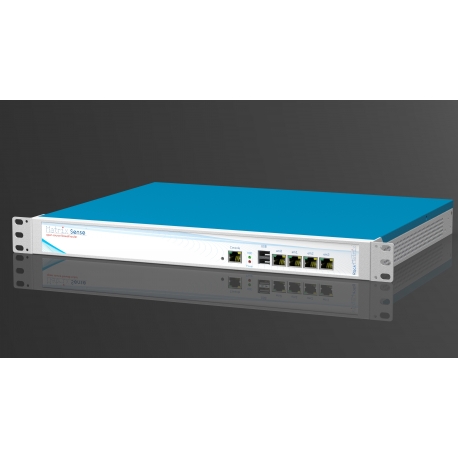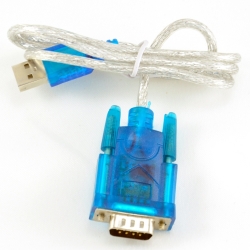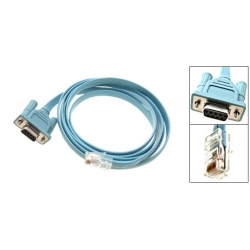Cart 0 Product Products (empty)
No products
To be determined Shipping
0,00 € Total
Prices are tax excluded
Product successfully added to your shopping cart
Quantity
Total
There are 0 items in your cart. There is 1 item in your cart.
Total products (tax excl.)
Total shipping (tax excl.) To be determined
Total (tax excl.)

* non-contractual pictures
firewall router - Matrix Sense - 1U Rack 4 ports GbE Intel quad-core 2 Ghz
Product replaced by RMT-CASE-M1-BDL0016
- Rack 1U 19"
- 4 ports GbE Intel
- 2 GHz Intel® Celeron quad-core
- 2/4/8 GB DDR3 DRAM
- pfsense® pre-installed software
RMT-FWR11004#D
New product
- Remove this product from my favorite's list.
- Add this product to my list of favorites.
More info
Description
The Matrix Sense router firewall is a high quality rackable firewall solution with pre-installed pfSense® v2.x.x software in 1U rack format, with Intel Celeron J1900 quad core 2Ghz, 4 GB memory, 4 x 10/100/1000Mbps Intel Gigabit Ethernet ports.
Custom front panel UV print
Rack Matrix® technology
pfSense® software
This product is pre-installed with pfSense® software v2 release.
Custom front panel UV print
Please contact us for high quality front panel UV print (logo, custom port labels, etc..)
Rack Matrix® technology
High quality 1U modular enclosure built by Rack Matrix Technology with the best materials available.
pfSense® software
The pfSense software is a free network firewall distribution, based on the FreeBSD operating system with a custom kernel and including third party free software packages for additional functionality. pfSense software, with the help of the package system, is able to provide the same functionality or more of common commercial firewalls, without any of the artificial limitations. It has successfully replaced every big name commercial firewall you can imagine in numerous installations around the world. pfSense software includes a web interface for the configuration of all included components. There is no need for any UNIX knowledge, no need to use the command line for anything, and no need to ever manually edit any rule sets. Users familiar with commercial firewalls catch on to the web interface quickly, though there can be a learning curve for users not familiar with commercial-grade firewalls.
pfSense is a trademark of Electric Sheep Fencing LLC
pfSense is a trademark of Electric Sheep Fencing LLC
This product is pre-installed with pfSense® software v2 release.
Hardware
| System board | Yanyu gongkong ITX-M9E |
| CPU | Intel Celeron J1900 Quad core, 2 GHz |
| Memory | 2/4 or 8 GB DDR3-1333 DRAM |
| E/S | 4 x Gigabit Intel 10/100/1000 Mbps ports (Intel 210AT) |
| RJ45 Serial port (console CISCO format) | |
| 2 x USB 2.0 | |
| Storage | mSATA: 16GB up to 120GB Industrial HDD: 500GB or 1TB |
| Dimensions | 343 x 430 x 44 mm |
| Power | internal 90 - 264V power supply with light and fuse protection or 12V external power supply |
| Warranty | 1 year (material, return in our workshop), 3 years (optional) |
Features
- Filtering by source and destination IP, IP protocol, source and destination port for TCP and UDP traffic
- Limit simultaneous connections on a per-rule basis
- pfSense software utilizes p0f, an advanced passive OS/network fingerprinting utility to allow you to filter by the Operating System initiating the connection. Want to allow FreeBSD and Linux machines to the Internet, but block Windows machines? pfSense software allows for that (amongst many other possibilities) by passively detecting the Operating System in use.
- Option to log or not log traffic matching each rule.
- Highly flexible policy routing possible by selecting gateway on a per-rule basis (for load balancing, failover, multiple WAN, etc.)
- Aliases allow grouping and naming of IPs, networks and ports. This helps keep your firewall ruleset clean and easy to understand, especially in environments with multiple public IPs and numerous servers.
- Transparent layer 2 firewalling capable - can bridge interfaces and filter traffic between them, even allowing for an IP-less firewall (though you probably want an IP for management purposes).
- Packet normalization - Description from the pf scrub documentation - "'Scrubbing' is the normalization of packets so there are no ambiguities in interpretation by the ultimate destination of the packet. The scrub directive also reassembles fragmented packets, protecting some operating systems from some forms of attack, and drops TCP packets that have invalid flag combinations."
- Enabled in the pfSense software by default
- Can disable if necessary. This option causes problems for some NFS implementations, but is safe and should be left enabled on most installations.
- Disable filter - you can turn off the firewall filter entirely if you wish to turn your pfSense software into a pure router.
The firewall's state table maintains information on your open network connections. The pfSense software is a stateful firewall, by default all rules are stateful.
Most firewalls lack the ability to finely control your state table. The pfSense software has numerous features allowing granular control of your state table, thanks to the abilities of FreeBSD's ported version of pf.
Adjustable state table size - there are multiple production pfSense installations using several hundred thousand states. The default state table size varies according to the RAM installed in the system, but it can be increased on the fly to your desired size. Each state takes approximately 1 KB of RAM, so keep in mind memory usage when sizing your state table. Do not set it arbitrarily high.
On a per-rule basis:
State types: the pfSense software offers multiple options for state handling.
State table optimization options: pf offers four options for state table optimization.
Most firewalls lack the ability to finely control your state table. The pfSense software has numerous features allowing granular control of your state table, thanks to the abilities of FreeBSD's ported version of pf.
Adjustable state table size - there are multiple production pfSense installations using several hundred thousand states. The default state table size varies according to the RAM installed in the system, but it can be increased on the fly to your desired size. Each state takes approximately 1 KB of RAM, so keep in mind memory usage when sizing your state table. Do not set it arbitrarily high.
On a per-rule basis:
- Limit simultaneous client connections
- Limit states per host
- Limit new connections per second
- Define state timeout
- Define state type
State types: the pfSense software offers multiple options for state handling.
- Keep state - Works with all protocols. Default for all rules.
- Sloppy state - Works with all protocols. Less strict state tracking, useful in cases of asymmetric routing.
- Synproxy state - Proxies incoming TCP connections to help protect servers from spoofed TCP SYN floods. This option includes the functionality of keep state and modulate state combined.
- None - Do not keep any state entries for this traffic. This is very rarely desirable, but is available because it can be useful under some limited circumstances.
State table optimization options: pf offers four options for state table optimization.
- Normal - the default algorithm
- High latency - Useful for high latency links, such as satellite connections. Expires idle connections later than normal.
- Aggressive - Expires idle connections more quickly. More efficient use of hardware resources, but can drop legitimate connections.
- Conservative - Tries to avoid dropping legitimate connections at the expense of increased memory usage and CPU utilization.
- Port forwards including ranges and the use of multiple public IPs
- 1:1 NAT for individual IPs or entire subnets.
- Outbound NAT
- Default settings NAT all outbound traffic to the WAN IP. In multiple WAN scenarios, the default settings NAT outbound traffic to the IP of the WAN interface being used.
- Advanced Outbound NAT allows this default behavior to be disabled, and enables the creation of very flexible NAT (or no NAT) rules.
- NAT Reflection - NAT reflection is possible so services can be accessed by public IP from internal networks.
PPTP / GRE Limitations:
The state tracking code in pf for the GRE protocol can only track a single session per public IP per external server. This means if you use PPTP VPN connections, only one internal machine can connect simultaneously to a PPTP server on the Internet. A thousand machines can connect simultaneously to a thousand different PPTP servers, but only one simultaneously to a single server. The only available work around is to use multiple public IPs on your firewall, one per client, or to use multiple public IPs on the external PPTP server. This is not a problem with other types of VPN connections. PPTP is insecure and should no longer be used.
The state tracking code in pf for the GRE protocol can only track a single session per public IP per external server. This means if you use PPTP VPN connections, only one internal machine can connect simultaneously to a PPTP server on the Internet. A thousand machines can connect simultaneously to a thousand different PPTP servers, but only one simultaneously to a single server. The only available work around is to use multiple public IPs on your firewall, one per client, or to use multiple public IPs on the external PPTP server. This is not a problem with other types of VPN connections. PPTP is insecure and should no longer be used.
The combination of CARP, pfsync, and our configuration synchronization provides high availability functionality. Two or more firewalls can be configured as a failover group. If one interface fails on the primary or the primary goes offline entirely, the secondary becomes active. The pfSense software also includes configuration synchronization capabilities, so you make your configuration changes on the primary and they automatically synchronize to the secondary firewall.
The firewall's state table is replicated to all failover configured firewalls. This means your existing connections will be maintained in the case of failure, which is important to prevent network disruptions.
The firewall's state table is replicated to all failover configured firewalls. This means your existing connections will be maintained in the case of failure, which is important to prevent network disruptions.
Multi-WAN functionality enables the use of multiple Internet connections, with load balancing and/or failover, for improved Internet availability and bandwidth usage distribution.
Server load balancing is used to distribute load between multiple servers. This is commonly used with web servers, mail servers, and others. Servers that fail to respond to ping requests or TCP port connections are removed from the pool.
The pfSense software offers three options for VPN connectivity, IPsec and OpenVPN.
IPsec
OpenVPN
IPsec
IPsec allows connectivity with any device supporting standard IPsec. This is most commonly used for site to site connectivity to other pfSense installations and most all other firewall solutions (Cisco, Juniper, etc.). It can also be used for mobile client connectivity.
OpenVPN
OpenVPN is a flexible, powerful SSL VPN solution supporting a wide range of client operating systems.
The pfSense software offers a PPPoE server. A local user database can be used for authentication, and RADIUS authentication with optional accounting is also supported.
RRD Graphs
The RRD graphs in the pfSense software maintain historical information on the following.
Real Time Information - CPU utilization
- Total throughput
- Firewall states
- Individual throughput for all interfaces
- Packets per second rates for all interfaces
- WAN interface gateway(s) ping response times
- Traffic shaper queues on systems with traffic shaping enabled
Historical information is important, but sometimes it's more important to see real time information.
- SVG graphs are available that show real time throughput for each interface.
- For traffic shaper users, the Status -> Queues screen provides a real time display of queue usage using AJAX updated gauges.
- The front page includes AJAX gauges for display of real time CPU, memory, swap and disk usage, and state table size.
A Dynamic DNS client is included to allow you to register your public IP with a number of dynamic DNS service providers.
- Custom - allowing defining update method for providers not specifically listed here.
- DNS-O-Matic
- DynDNS
- DHS
- DNSexit
- DyNS
- easyDNS
- freeDNS
- HE.net
- Loopia
- Namecheap
- No-IP
- ODS.org
- OpenDNS
- Route 53
- SelfHost
- ZoneEdit
Captive portal allows you to force authentication, or redirection to a click through page for network access. This is commonly used on hot spot networks, but is also widely used in corporate networks for an additional layer of security on wireless or Internet access. For more information on captive portal technology in general.
The following is a list of features in the pfSense Captive Portal:
The following is a list of features in the pfSense Captive Portal:
- Maximum concurrent connections - Limit the number of connections to the portal itself per client IP. This feature prevents a denial of service from client PCs sending network traffic repeatedly without authenticating or clicking through the splash page.
- Idle timeout - Disconnect clients who are idle for more than the defined number of minutes.
- Hard timeout - Force a disconnect of all clients after the defined number of minutes.
- Logon pop up window - Option to pop up a window with a log off button.
- URL Redirection - after authenticating or clicking through the captive portal, users can be forcefully redirected to the defined URL.
- MAC filtering - by default, pfSense filters using MAC addresses. If you have a subnet behind a router on a captive portal enabled interface, every machine behind the router will be authorized after one user is authorized. MAC filtering can be disabled for these scenarios.
- Authentication options - There are three authentication options available.
- No authentication - This means the user just clicks through your portal page without entering credentials.
- Local user manager - A local user database can be configured and used for authentication.
- RADIUS authentication - This is the preferred authentication method for corporate environments and ISPs. It can be used to authenticate from Microsoft Active Directory and numerous other RADIUS servers.
- RADIUS capabilities
- Forced re-authentication
- Able to send Accounting updates
- RADIUS MAC authentication allows captive portal to authenticate to a RADIUS server using the client's MAC address as the user name and password.
- Allows configuration of redundant RADIUS servers.
- HTTP or HTTPS - The portal page can be configured to use either HTTP or HTTPS.
- Pass-through MAC and IP addresses - MAC and IP addresses can be white listed to bypass the portal. Any machines with NAT port forwards will need to be bypassed so the reply traffic does not hit the portal. You may wish to exclude some machines for other reasons.
- File Manager - This allows you to upload images for use in your portal pages.
The pfSense software includes both DHCP Server and Relay functionality




